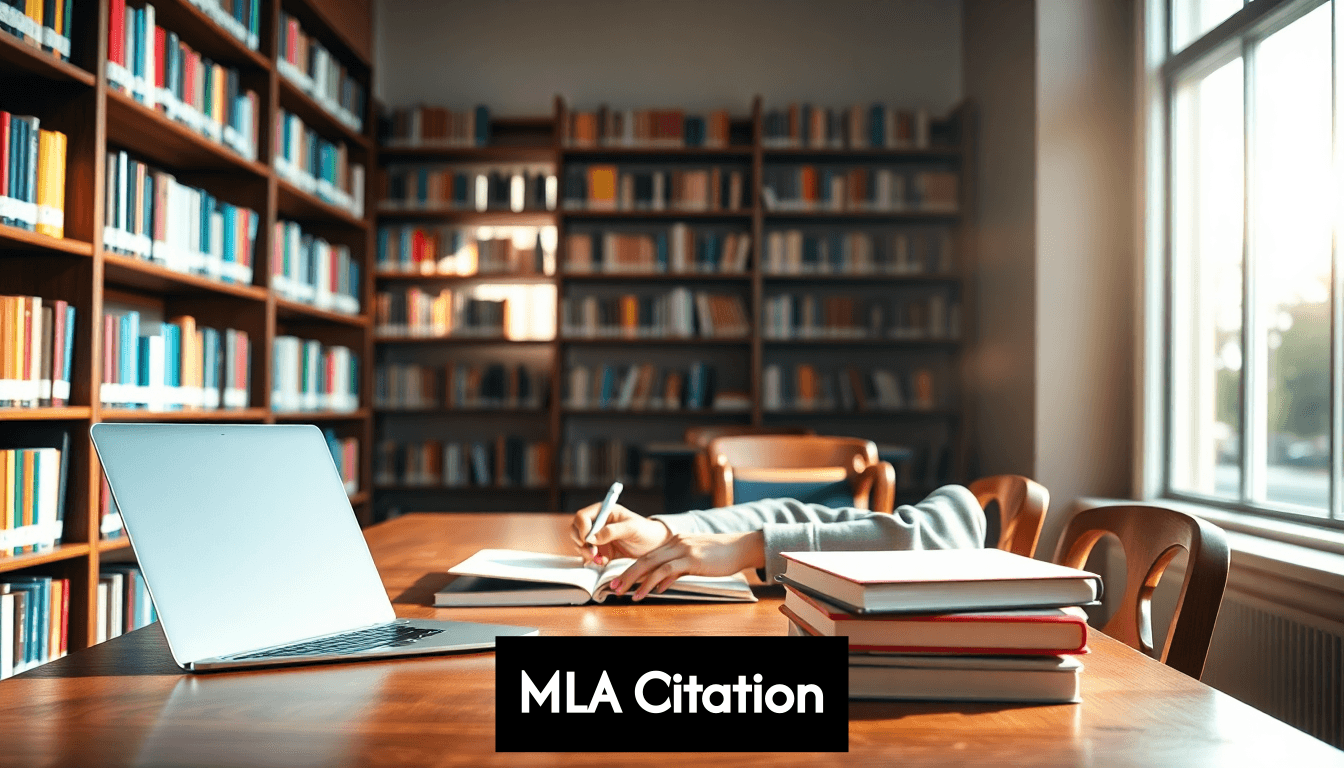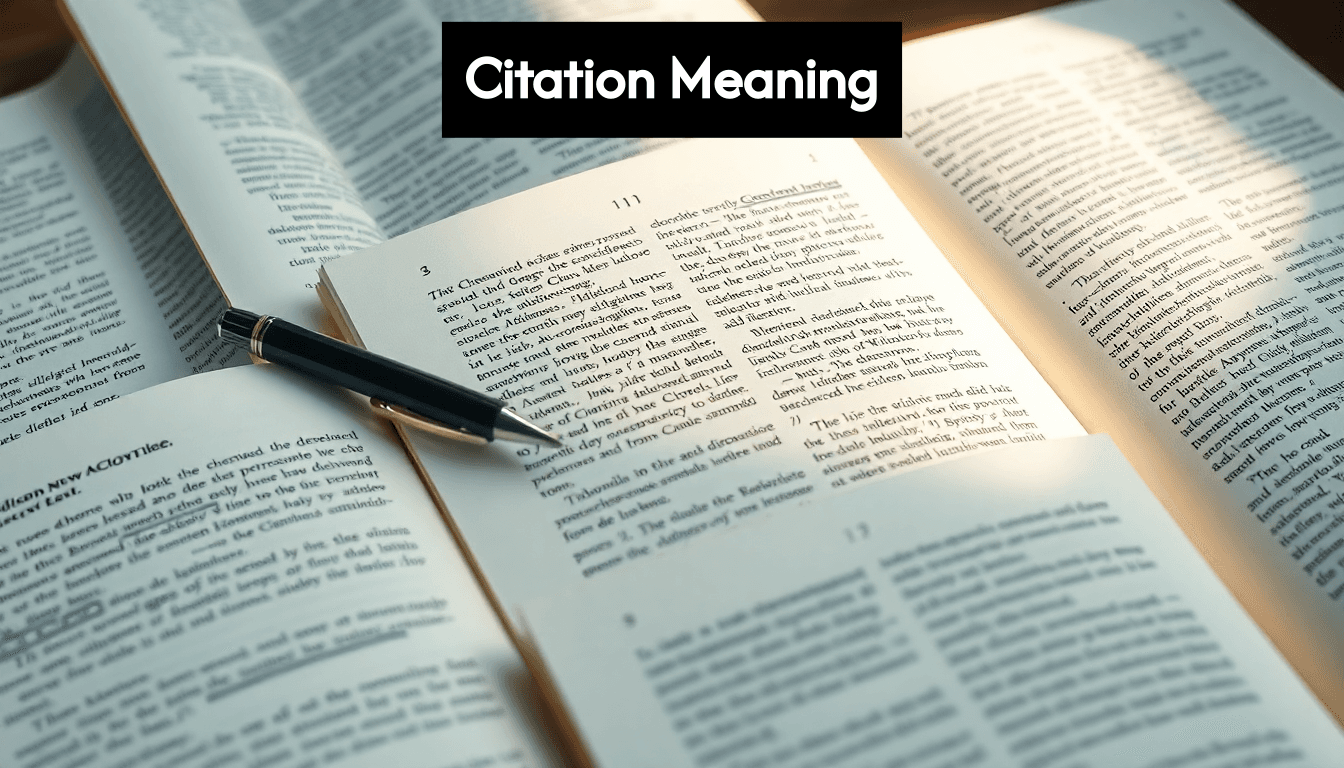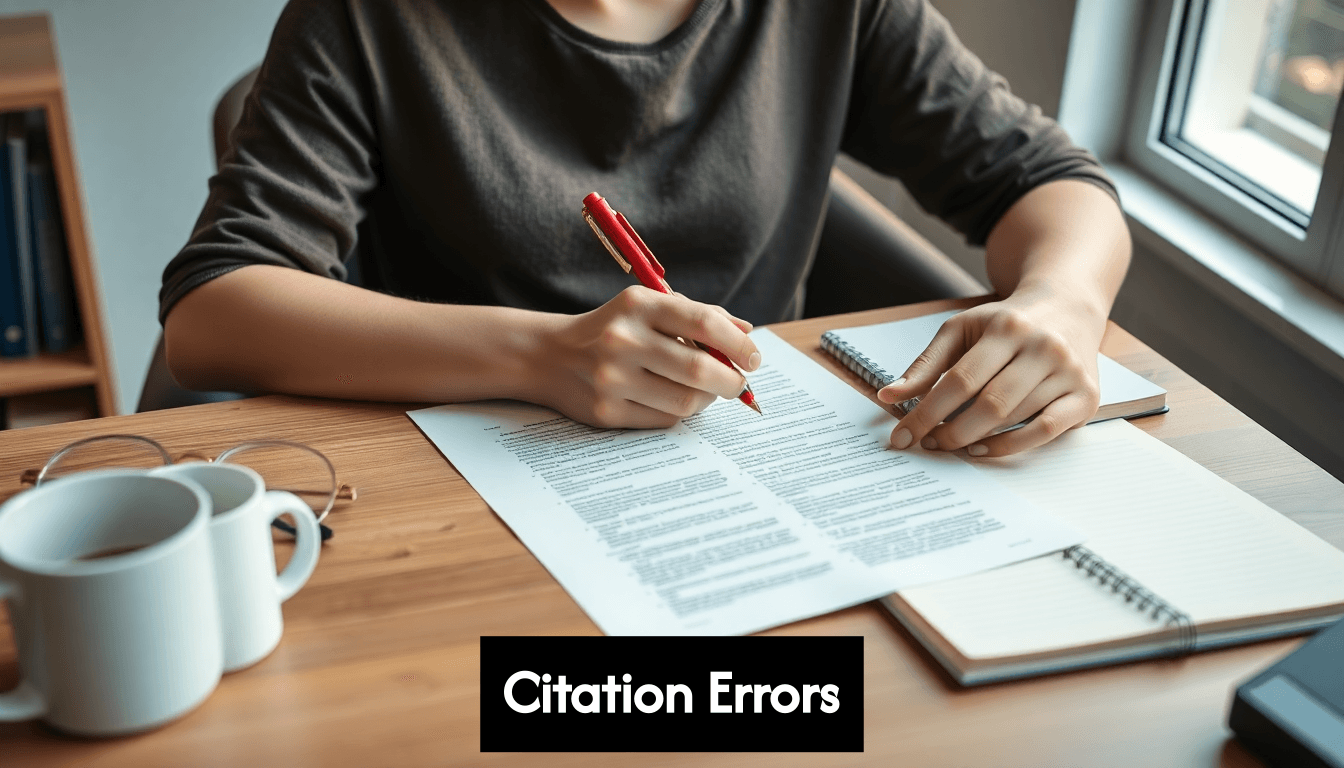Blog
Learning Materials
Ihr ultimativer Leitfaden 2025 zum Verständnis von MLA-Zitierungen
Updated: April 27, 2025

MLA-Zitation ist grundlegend für alle, die sich mit akademischem Schreiben beschäftigen, insbesondere in den Geisteswissenschaften. Mit 75 % der Studierenden, die Zitationsfehler machen, ist das Verständnis dieses Zitationsstils nicht nur vorteilhaft, sondern entscheidend. Doch hier ist der Clou: Viele glauben, dass sich MLA nur auf das Zitieren von Büchern und Artikeln bezieht. Tatsächlich deckt seine Flexibilität alles ab, von Social-Media-Posts bis hin zu digitalen Videos. Das Beherrschen von MLA kann Ihr Schreiben aufwerten und akademische Integrität sowie Klarheit in Ihrer Forschung sicherstellen.
Inhaltsverzeichnis
- Definition der Bedeutung von MLA-Zitation
- Was bedeutet MLA?
- Kernelemente der MLA-Zitation
- Zweck der MLA-Zitation
- Wichtige MLA-Zitationsrichtlinien
- Grundlagen der In-Text-Zitation
- Struktur der Works Cited-Seite
- Zitieren verschiedener Quellentypen
- Aktuelle Updates zu den MLA-Richtlinien
- Praktische MLA-Zitationsbeispiele
- Buchzitationen
- Zeitschriftenartikel
- Website-Zitationen
- Medienzitationen
- Social-Media-Zitationen
- Tabelle der häufigen Zitationsmuster
- Vermeidung häufiger Zitationsfehler
- Inkonsistente Formatierung
- Falsches In-Text-Zitationsformat
- Fehlende oder unvollständige Works Cited-Einträge
- Falsche Anwendung von Zitationselementen
- Veraltete Zitationspraktiken
- Fehler bei der Zitation digitaler Quellen
- Über- und Unterzitation
Kurze Zusammenfassung
| Erkenntnis | Erklärung |
|---|---|
| Verständnis der Kernelemente | Machen Sie sich mit den neun Kernelementen der MLA-Zitation vertraut: Autor, Titel der Quelle, Titel des Containers, andere Mitwirkende, Version, Nummer, Verlag, Veröffentlichungsdatum und Ort, um die richtige Reihenfolge und Formatierung sicherzustellen. |
| In-Text-Zitationen | Verwenden Sie den Nachnamen des Autors und die Seitenzahl in Klammern für In-Text-Zitationen, um Klarheit und Zuordnung in Ihrem Schreiben zu priorisieren, ohne unnötig Veröffentlichungsjahre einzubeziehen. |
| Anforderungen an die Works Cited-Seite | Die Works Cited-Seite muss korrekt betitelt, mit hängendem Einzug formatiert, doppelt gespaced und die Einträge nach dem Nachnamen des Autors alphabetisch geordnet sein, um Konsistenz und Integrität in den Zitationen zu wahren. |
| Anpassungsfähigkeit für Quellentypen | Erkennen Sie, dass die MLA-Zitation verschiedene Quellen, einschließlich digitaler Medien, sozialer Plattformen und mehr, aufnehmen kann und sich an veränderte Forschungspraktiken und die digitale Landschaft anpasst. |
| Vermeidung häufiger Fehler | Seien Sie sich häufiger Zitationsfehler wie inkonsistenter Formatierung, fehlender Zitationen, falscher Anwendung von Zitationselementen bewusst und bleiben Sie auf dem neuesten Stand der MLA-Richtlinien, um akademische Integrität zu wahren. |
Definition der Bedeutung von MLA-Zitation

Die MLA-Zitation bezieht sich auf ein spezifisches Format zur Anerkennung von Quellen im akademischen Schreiben, das von der Modern Language Association erstellt und gepflegt wird. Das Verständnis der Bedeutung der MLA-Zitation ist für Studierende, Forscher und Schriftsteller in den Geisteswissenschaften unerlässlich. Lassen Sie uns die Definition, den Zweck und die Schlüsselelemente des MLA-Zitationsformats erkunden.
Was bedeutet MLA?
MLA steht für die Modern Language Association, die Organisation, die diesen Zitationsstil etabliert hat. Laut dem MLA Style Center wird dieses Zitationssystem hauptsächlich für Forschungsarbeiten in den Geisteswissenschaften verwendet, insbesondere in den Bereichen Englischstudien, vergleichende Literatur, fremdsprachige Literatur und Kulturstudien. Die Abkürzung MLA ist gleichbedeutend mit einer spezifischen Methode zur Zitation von Quellen und zur Formatierung akademischer Arbeiten geworden.
Die Bedeutung der MLA-Zitation geht über die bloße Quellenangabe hinaus – sie repräsentiert einen standardisierten Ansatz für akademische Integrität und wissenschaftliche Kommunikation. Wie Elaine P. Maimon, ehemalige Präsidentin des Council of Writing Program Administrators, erklärt: Der Fokus der MLA auf Klarheit und Nachvollziehbarkeit bedeutet, dass Forscher, Studierende und Leser gleichermaßen die Integrität und akademische Ehrlichkeit der Arbeit sicherstellen können. Dieser Fokus auf Klarheit hilft, akademische Standards über Disziplinen hinweg aufrechtzuerhalten.
Kernelemente der MLA-Zitation
Das Verständnis der Bedeutung der MLA-Zitation erfordert die Vertrautheit mit ihren grundlegenden Komponenten. Laut dem MLA-Leitfaden des Columbia College basiert das MLA-System auf neun Kernelementen für alle Zitationseinträge:
- Autor
- Titel der Quelle
- Titel des Containers
- Andere Mitwirkende
- Version
- Nummer
- Verlag
- Veröffentlichungsdatum
- Ort
Diese Elemente bilden das Rückgrat der MLA-Zitationen, obwohl nicht jede Zitation alle neun Elemente erfordert. Das System ist so konzipiert, dass es flexibel ist und gleichzeitig Konsistenz über verschiedene Quellentypen hinweg bewahrt.
Zweck der MLA-Zitation
Die Definition der Bedeutung der MLA-Zitation umfasst auch das Verständnis ihres Zwecks. Die MLA-Zitation erfüllt mehrere wichtige Funktionen:
- Zuordnung: Die ordnungsgemäße Anerkennung der ursprünglichen Autoren oder Schöpfer der Materialien, die Sie referenzieren
- Verifizierung: Den Lesern die Möglichkeit geben, Ihre Quellen zu finden und zu überprüfen
- Kontext: Kontext für Ihre Forschung innerhalb bestehender akademischer Gespräche bieten
- Akademische Integrität: Autoren helfen, Plagiate zu vermeiden, indem sie klar angeben, wann sie die Ideen anderer verwenden
Im Gegensatz zu einigen anderen Zitationsstilen wie APA oder Chicago betont MLA die Verwendung des Namens des Autors und der Seitenzahl in In-Text-Zitationen, anstatt des Veröffentlichungsjahres. Dies spiegelt den Fokus der MLA auf die Textanalyse wider, die in den Geisteswissenschaften üblich ist, wo die spezifischen Wörter und Orte innerhalb von Texten oft relevanter sind als die Veröffentlichungsdaten.
Ein häufiger Irrglaube ist, dass die MLA-Zitation nur für Bücher und Druckquellen gilt. Tatsächlich unterstützt der MLA Style Center nun die Zitation einer Vielzahl von Quellentypen, einschließlich digitaler Medien, sozialer Plattformen, audiovisueller Materialien und mehr. Diese Anpassungsfähigkeit stellt sicher, dass MLA in unserer zunehmend digitalen akademischen Landschaft relevant bleibt.
Das Verständnis der Bedeutung der MLA-Zitation ist der erste Schritt zur Beherrschung dieser wichtigen akademischen Fähigkeit – eine, die Ihnen während Ihrer Bildungs- und Berufslaufbahn in den Geisteswissenschaften gute Dienste leisten wird.
Wichtige MLA-Zitationsrichtlinien
Das Beherrschen der wesentlichen Richtlinien der MLA-Zitation hilft Ihnen, Quellen in Ihrem akademischen Schreiben ordnungsgemäß zuzuordnen. Diese Richtlinien bieten den Rahmen für konsistente, klare Zitationen, die akademische Integrität wahren. Lassen Sie uns die grundlegenden Regeln erkunden, die die ordnungsgemäße Praxis der MLA-Zitation definieren.
Grundlagen der In-Text-Zitation
In-Text-Zitationen im MLA-Format folgen spezifischen Regeln, die darauf abzielen, die Quellenangabe nahtlos in Ihr Schreiben zu integrieren. Im Gegensatz zum APA-Stil, der das Veröffentlichungsjahr betont, priorisiert MLA den Namen des Autors und die spezifische Seite, auf der die Informationen erscheinen.
Das grundlegende Format für eine MLA-In-Text-Zitation ist einfach: der Nachname des Autors gefolgt von einer Seitenzahl in Klammern. Zum Beispiel: (Smith 45). Dieses Format verweist die Leser auf Seite 45 eines Werks eines Autors namens Smith, mit vollständigen Veröffentlichungsdetails, die in Ihrer Works Cited-Liste verfügbar sind.
Wenn Sie den Namen des Autors in Ihrem Satz erwähnen, müssen Sie nur die Seitenzahl in Klammern angeben: Laut Smith war die Wirkung sofort und tiefgreifend (45). Dieser Ansatz schafft einen natürlichen Fluss in Ihrem Schreiben und bietet dennoch die notwendige Zuordnung.
Eine Umfrage des MLA Style Center ergab, dass etwa 75 % der Zitationsformatierungsfehler die falsche Verwendung von In-Text-Zitationen oder das Fehlen von Kernelementen betreffen. Das Verständnis dieser Grundlagen hilft Ihnen, häufige Fallstricke zu vermeiden.
Struktur der Works Cited-Seite
Die Works Cited-Seite ist ein entscheidender Bestandteil der Bedeutung der MLA-Zitation. Diese umfassende Liste erscheint am Ende Ihrer Arbeit und bietet vollständige Informationen zu jeder Quelle, die Sie referenziert haben.
Wichtige Formatierungsanforderungen für die Works Cited-Seite umfassen:
- Zentrieren Sie den Titel Works Cited oben (keine Fettschrift, Kursivschrift oder Anführungszeichen)
- Doppeltabstand für alle Einträge (sowohl innerhalb als auch zwischen den Einträgen)
- Verwenden Sie hängenden Einzug (erste Zeile bündig links, nachfolgende Zeilen eingerückt um 0,5 Zoll)
- Alphabetisieren Sie die Einträge nach dem Nachnamen des Autors (oder Titel, wenn kein Autor angegeben ist)
Wie Gerald Graff, Professor Emeritus für Englisch und Bildung an der University of Illinois in Chicago, erklärt: Indem sie Autor und Seite in Zitationen betont, fördert die MLA das Engagement mit dem ursprünglichen intellektuellen Kontext, was für die literarische Wissenschaft entscheidend ist. Dieses Engagement erstreckt sich auf die Works Cited-Seite, die den vollständigen Kontext für Ihre Quellen bietet.
Zitieren verschiedener Quellentypen
Die MLA-Zitationsrichtlinien decken eine umfangreiche Palette von Quellentypen ab. Die MLA 9. Ausgabe, die neueste Version, bietet aktualisierte Anleitungen zum Zitieren verschiedener Quellen, einschließlich digitaler und Online-Medien.
Ein häufiger Irrglaube ist, dass die MLA-Zitation nur für traditionelle Druckquellen geeignet ist. Tatsächlich hat sich die MLA weiterentwickelt, um praktisch alle Medientypen aufzunehmen:
- Bücher: Enthält Autor, Titel, Verlag und Veröffentlichungsdatum
- Zeitschriftenartikel: Enthält Autor, Artikeltitel, Zeitschriftenname, Band, Ausgabe, Datum und Seitenzahlen
- Websites: Enthält Autor (falls verfügbar), Seitentitel, Website-Name, Verlag (falls abweichend von der Website), Veröffentlichungsdatum und URL
- Videos: Enthält Ersteller, Titel, Plattform, Verlag, Upload-Datum und URL
- Soziale Medien: Enthält den Handle des Autors, Text des Beitrags (bei Bedarf abgekürzt), Plattform, Datum und URL
Die Zitation digitaler Quellen im MLA-Format hat zwischen 2021 und 2024 um 30 % zugenommen, was die zunehmende Abhängigkeit von Online-Ressourcen im wissenschaftlichen Schreiben widerspiegelt. Die Flexibilität der MLA-Richtlinien ermöglicht die ordnungsgemäße Zitation dieser vielfältigen Quellen.
Aktuelle Updates zu den MLA-Richtlinien
Auf dem neuesten Stand der MLA-Zitationsrichtlinien zu bleiben, ist entscheidend, da sie sich weiterentwickeln, um sich ändernden Forschungspraktiken anzupassen. Die neueste Ausgabe (MLA 9.) führte mehrere wichtige Änderungen ein:
- Größere Flexibilität im Zitationsformat, um neue Medientypen aufzunehmen
- Vereinfachter Ansatz unter Verwendung der neun Kernelemente in einer bestimmten Reihenfolge
- Erweiterte Anleitung zum Zitieren digitaler Materialien, einschließlich Social-Media-Posts
- Standardisierte Verwendung von URLs (ohne http:// oder https://)
Laut Lesley S. J. Goldberg, Direktorin des MLA Style Center, ist die Flexibilität des MLA-Stils, neue Quellentypen wie Tweets und Online-Videos aufzunehmen, entscheidend für Studierende, die mit digitalen Medientrends Schritt halten. Diese Anpassungsfähigkeit stellt sicher, dass die MLA-Zitation in unserer zunehmend digitalen akademischen Landschaft relevant bleibt.
Durch das Verständnis und die Anwendung dieser wichtigen MLA-Zitationsrichtlinien sind Sie gut gerüstet, um Quellen in Ihrem akademischen Schreiben ordnungsgemäß zuzuordnen und sowohl wissenschaftliche Integrität als auch Klarheit für Ihre Leser zu wahren.
Praktische MLA-Zitationsbeispiele
Manchmal ist der beste Weg, die Bedeutung der MLA-Zitation zu verstehen, sie in Aktion zu sehen. Dieser Abschnitt bietet praktische Beispiele dafür, wie verschiedene Quellentypen im MLA-Format zitiert werden, gemäß den aktuellen Richtlinien der MLA 9. Ausgabe. Diese Beispiele helfen Ihnen, sowohl In-Text-Zitationen als auch Works Cited-Einträge für häufige Quellentypen korrekt zu formatieren.
Buchzitationen
Bücher sind grundlegende Quellen im akademischen Schreiben. Egal, ob Sie ein Buch mit einem einzigen Autor, ein mehrbändiges Werk oder eine herausgegebene Sammlung zitieren, die MLA bietet klare Richtlinien.
Für ein Standardbuch mit einem einzigen Autor enthält die In-Text-Zitation den Nachnamen des Autors und die Seitenzahl: (Johnson 42). Der entsprechende Works Cited-Eintrag folgt diesem Format:
Johnson, Sarah M. The Evolution of Literary Theory. Oxford University Press, 2023.
Für ein Buch mit mehreren Autoren geben Sie den Namen des ersten Autors gefolgt von et al. in Ihrer In-Text-Zitation an: (Garcia et al. 156). In Ihrer Works Cited-Liste geben Sie die Namen aller Autoren (bis zu drei) in der Reihenfolge an, in der sie auf der Quelle erscheinen:
Garcia, Manuel, Jennifer Wilson, and Robert Chang. Modern Approaches to Literary Criticism. Stanford University Press, 2024.
Zeitschriftenartikel
Zeitschriftenartikel erfordern spezifische Formatierungsdetails im MLA-Stil. Für In-Text-Zitationen verwenden Sie den Nachnamen des Autors und die Seitenzahl: (Martinez 78). Der Works Cited-Eintrag sollte die Band- und Ausgabenummern der Zeitschrift enthalten:
Martinez, Elena. Reimagining Feminist Discourse in Contemporary Literature. Journal of Literary Studies, vol. 45, no. 2, 2024, pp. 67-89.
Für Online-Zeitschriftenartikel geben Sie eine DOI (Digital Object Identifier) an, falls verfügbar, oder eine URL, wenn keine DOI vorhanden ist:
Paterson, Thomas J. Digital Narratives and Interactive Storytelling. Technology & Literature, vol. 12, no. 3, 2023, pp. 112-130. DOI: 10.1080/15536548.2023.1234567.
Das MLA Style Center betont, dass sich der MLA-Zitationsstil weiterentwickelt hat, um Medien über den Druck hinaus aufzunehmen, was ihn anpassungsfähig an verschiedene wissenschaftliche Quellen unabhängig vom Format macht.
Website-Zitationen
Websites sind zunehmend häufige Quellen im akademischen Schreiben. Für In-Text-Zitationen von Websites ohne Seitenzahlen verwenden Sie nur den Namen des Autors: (Reynolds). Wenn kein Autor verfügbar ist, verwenden Sie eine verkürzte Version des Titels in Anführungszeichen: (Climate Change Report).
Der Works Cited-Eintrag für eine Website enthält den Autor (falls verfügbar), den Titel der Seite, den Namen der Website, den Verlag (falls abweichend vom Website-Namen), das Veröffentlichungsdatum und die URL:
Reynolds, Catherine. The Impact of Climate Change on Literature. Literary Studies Online, 12 Mar. 2024, www.literarystudiesonline.org/climate-impact.
Climate Change Report: Literary Responses to Environmental Crisis. Global Literary Forum, 5 Jan. 2023, www.globalliteraryforum.org/climate-report.
Medienzitationen
Laut einer Umfrage von 2023, die vom MLA Style Center zitiert wird, bevorzugen 67 % der Dozenten, die Kurse im Grundstudium unterrichten, den MLA-Zitationsstil für Aufgaben, die literarische Analysen beinhalten, einschließlich solcher, die sich auf Medienquellen beziehen. Hier erfahren Sie, wie Sie verschiedene Medientypen zitieren:
Film oder Video: In-Text: (Moonlight) Works Cited: Moonlight. Directed by Barry Jenkins, A24, 2016.
YouTube-Video: In-Text: (TED) Works Cited: TED. The Power of Literary Fiction. YouTube, uploaded by TEDTalks, 15 Apr. 2023, www.youtube.com/watch?v=example123.
Podcast-Episode: In-Text: (Williams) Works Cited: Williams, Sarah. Contemporary Poetry and Social Change. Literature Today, episode 45, NPR, 23 Nov. 2024, www.npr.org/podcasts/literature-today/episode45.
Social-Media-Zitationen
Social-Media-Zitationen sind in akademischen Arbeiten zunehmend notwendig geworden, insbesondere wenn es um zeitgenössische Diskurse geht. Für Tweets oder ähnliche kurze Beiträge verwenden Sie den Handle des Autors in der In-Text-Zitation: (@LitStudies). Der Works Cited-Eintrag sollte den echten Namen des Autors (falls bekannt), den Handle, den Text des Beitrags (bis zu 280 Zeichen), die Plattform, das Datum und die URL enthalten:
@LitStudies (Literary Studies Association). New research shows increased engagement with classic texts when taught alongside contemporary works that address similar themes. #literaryeducation. Twitter, 14 May 2024, twitter.com/LitStudies/status/123456789.
Die MLA 9. Ausgabe behandelt speziell Social-Media-Zitationen und erkennt deren wachsende Bedeutung in wissenschaftlichen Diskussionen an.
Tabelle der häufigen Zitationsmuster
| Quellentyp | In-Text-Zitationsmuster | Erstes Element der Works Cited |
|---|---|---|
| Buch (1 Autor) | (Smith 42) | Smith, John. |
| Buch (2-3 Autoren) | (Jones et al. 67) | Jones, Mary, et al. |
| Zeitschriftenartikel | (Wilson 23) | Wilson, Sarah. |
| Website mit Autor | (Garcia) | Garcia, Manuel. |
| Website ohne Autor | (Artikel Titel) | Artikel Titel. |
| Film | (Filmtitel) | Filmtitel. |
| Soziale Medien | (@Handle) | @Handle (Echter Name). |
Wie der MLA-Leitfaden des Columbia College feststellt, ist ein häufiger Irrglaube über die MLA-Zitation, dass Sie immer jedes Kernelement einbeziehen müssen, wenn Sie eine Quelle zitieren. Tatsächlich besagen die MLA-Richtlinien, dass es akzeptabel ist, nicht anwendbare Kernelemente zu überspringen; nur Informationen einbeziehen, die vorhanden und relevant für die Quelle sind.
Durch das Studium dieser praktischen Beispiele entwickeln Sie ein besseres Verständnis der Bedeutung der MLA-Zitation und können Quellen in Ihrem eigenen akademischen Schreiben ordnungsgemäß zuordnen. Denken Sie daran, dass diese Beispiele die allgemeinen Muster veranschaulichen und spezifische Quellentypen möglicherweise kleine Variationen in der Formatierung erfordern.
Vermeidung häufiger Zitationsfehler

Selbst mit einem soliden Verständnis der Bedeutung und Richtlinien der MLA-Zitation können sich Fehler in Ihre Arbeit einschleichen. Das Erkennen und Vermeiden häufiger Zitationsfehler wird Ihr akademisches Schreiben stärken und Ihre wissenschaftliche Glaubwürdigkeit wahren. Lassen Sie uns die häufigsten Zitationsfehler und deren Vermeidung untersuchen.
Inkonsistente Formatierung
Inkonsistenz ist einer der häufigsten Zitationsfehler. Dies tritt auf, wenn Sie die MLA-Formatierung in Ihrer Arbeit unterschiedlich anwenden. Zum Beispiel manchmal et al. für mehrere Autoren verwenden und andere Male alle Autoren auflisten oder Buchtitel in einigen Zitationen kursiv setzen, in anderen jedoch nicht.
Um Inkonsistenz zu vermeiden:
- Erstellen Sie ein Zitationsstilblatt für Ihr Projekt, in dem Sie spezifische Formatierungsentscheidungen notieren
- Überprüfen Sie alle Zitationen zusammen während des Bearbeitungsprozesses, nicht nur, wenn Sie sie erstellen
- Verwenden Sie dasselbe Zitationsmuster für ähnliche Quellentypen in Ihrer gesamten Arbeit
Laut Forschung aus dem Research and Style Manual von York Catholic betreffen schätzungsweise 75 % der Zitationsformatierungsfehler in Studentenarbeiten die inkonsistente Anwendung von Zitationsregeln. Konsistenz in Ihrer gesamten Arbeit zu wahren, zeigt Aufmerksamkeit für Details und stärkt Ihre akademische Glaubwürdigkeit.
Falsches In-Text-Zitationsformat
Fehler bei In-Text-Zitationen können die Glaubwürdigkeit Ihrer Arbeit untergraben. Häufige Fehler umfassen:
- Seitenzahlen weglassen, wenn sie verfügbar sind
- Unnötige Informationen wie Veröffentlichungsjahre einfügen (die zum APA-Stil gehören)
- Zitate falsch formatieren
- Satzzeichen falsch um Zitationen platzieren
Denken Sie daran, dass MLA-In-Text-Zitationen im Allgemeinen diesem Format folgen: Nachname des Autors und Seitenzahl ohne dazwischenliegende Satzzeichen oder Abkürzungen (Smith 42). Wenn Sie ein direktes Zitat einfügen, steht der Punkt nach der Zitation: Die Beweise deuten auf eine andere Interpretation hin (Johnson 156).
Fehlende oder unvollständige Works Cited-Einträge
Eine überraschende Anzahl von Studierenden zitiert Quellen in ihrem Text, versäumt es jedoch, vollständige Einträge in ihrer Works Cited-Liste aufzunehmen, oder umgekehrt. Wie Purdue OWLs MLA guide erklärt, erfordert der MLA-Stil, dass Autoren sowohl In-Text-Zitationen als auch eine Works Cited-Liste einbeziehen, um sicherzustellen, dass Leser alle referenzierten Materialien direkt nachverfolgen können.
Um diesen Fehler zu vermeiden:
- Erstellen Sie Works Cited-Einträge sofort, wenn Sie sich entscheiden, eine Quelle zu verwenden
- Überprüfen Sie Ihre In-Text-Zitationen mit Ihrer Works Cited-Liste während der Überarbeitung
- Stellen Sie sicher, dass jede in Ihrer Arbeit erwähnte Quelle in Ihrer Works Cited-Liste erscheint
Falsche Anwendung von Zitationselementen
Die neun Kernelemente der MLA müssen in der richtigen Reihenfolge mit der richtigen Formatierung präsentiert werden. Häufige Fehler umfassen:
- Elemente in der falschen Reihenfolge platzieren
- Falsche Satzzeichen zwischen den Elementen verwenden
- Titel falsch formatieren (Buchtitel sollten kursiv sein, während Artikeltitel in Anführungszeichen stehen sollten)
- Unnötige Elemente einfügen oder erforderliche weglassen
Das MLA-System basiert darauf, diese Kernelemente konsistent anzuwenden: Autor, Titel der Quelle, Titel des Containers, andere Mitwirkende, Version, Nummer, Verlag, Veröffentlichungsdatum und Ort. Das Auswendiglernen dieser Reihenfolge hilft Ihnen, genaue Zitationen zu erstellen.
Veraltete Zitationspraktiken
Die MLA-Richtlinien entwickeln sich weiter, und die Verwendung veralteter Praktiken kennzeichnet Ihre Arbeit als nicht auf dem neuesten Stand. Die MLA 9. Ausgabe führte mehrere Änderungen gegenüber früheren Versionen ein, darunter:
- URLs müssen nicht mehr mit http:// oder https:// beginnen
- Die Stadt des Verlags muss für die meisten Verlage nicht mehr angegeben werden
- Die Abkürzung pp. für Seitenbereiche wird in einigen Kontexten verwendet, in anderen nicht
Um die Verwendung veralteter Richtlinien zu vermeiden, überprüfen Sie regelmäßig das MLA Style Center, das die einzige autorisierte Quelle im Internet für aktuelle MLA-Stil-Updates und Klarstellungen ist.
Fehler bei der Zitation digitaler Quellen
Da die Zitation digitaler Quellen zwischen 2021 und 2024 um 30 % zugenommen hat, sind Fehler beim Zitieren von Online-Quellen häufiger geworden. Viele Autoren haben Schwierigkeiten mit:
- Bestimmen, was den Container für Online-Quellen darstellt
- Entscheiden, welches Veröffentlichungsdatum verwendet werden soll, wenn mehrere Daten erscheinen
- Umgang mit Quellen ohne klaren Autor oder Veröffentlichungsdatum
- URLs korrekt formatieren
Für Quellen ohne klare Veröffentlichungsdaten empfiehlt die MLA die Verwendung von n.d. (kein Datum). Für Websites ohne Autoren beginnen Sie mit dem Titel der Seite. Denken Sie daran, dass Containertitel (wie Website-Namen) kursiv sein sollten, während Webseitentitel in Anführungszeichen stehen sollten.
Über- und Unterzitation
Das Finden des richtigen Gleichgewichts in der Zitationshäufigkeit kann eine Herausforderung sein. Überzitation – zu häufiges oder unnötiges Zitieren – stört den Fluss Ihres Schreibens. Unterzitation birgt das Risiko von Plagiaten, indem sie die Ideen anderer nicht anerkennt.
Als allgemeine Regel:
- Zitieren Sie, wenn Sie direkt zitieren
- Zitieren Sie, wenn Sie die einzigartige Idee oder Interpretation einer anderen Person umformulieren oder zusammenfassen
- Zitieren Sie Statistiken, Daten oder spezifische Fakten, die nicht allgemein bekannt sind
- Zitieren Sie keine Fakten, die allgemein bekannt sind oder in vielen Quellen zu finden sind
Durch das Verständnis dieser häufigen Zitationsfehler und das Ergreifen von Maßnahmen zu deren Vermeidung stärken Sie Ihr akademisches Schreiben und demonstrieren Ihr Engagement für wissenschaftliche Integrität. Denken Sie daran, dass die Aufmerksamkeit für Details in Zitationen Ihren gesamten Ansatz zur Forschung und zum Schreiben widerspiegelt – eine Qualität, die von Dozenten und Lesern hoch geschätzt wird.
Häufig gestellte Fragen
Was ist MLA-Zitation?
Die MLA-Zitation ist ein standardisiertes Format zur Anerkennung von Quellen im akademischen Schreiben, das von der Modern Language Association erstellt wurde. Es wird hauptsächlich in den Geisteswissenschaften verwendet und betont Klarheit und akademische Integrität.
Wofür steht MLA?
MLA steht für die Modern Language Association, die Organisation, die den MLA-Zitationsstil hauptsächlich für Forschungsarbeiten in Bereichen wie Englischstudien und Kulturstudien entwickelt hat.
Wie erstelle ich eine MLA Works Cited-Seite?
Um eine MLA Works Cited-Seite zu erstellen, zentrieren Sie den Titel Works Cited oben, doppeltabstand alle Einträge, verwenden Sie hängenden Einzug und alphabetisieren Sie die Einträge nach dem Nachnamen des Autors.
Was sind die Kernelemente der MLA-Zitation?
Die neun Kernelemente der MLA-Zitation umfassen Autor, Titel der Quelle, Titel des Containers, andere Mitwirkende, Version, Nummer, Verlag, Veröffentlichungsdatum und Ort. Diese Struktur stellt eine umfassende Anerkennung der Quellen sicher.
Verbessern Sie Ihr akademisches Schreiben mit Samwell.ai
Haben Sie Schwierigkeiten, MLA-Zitationen zu meistern und sicherzustellen, dass Ihre Quellen ordnungsgemäß zugeordnet sind? Sie sind nicht allein – über 75 % der Studierenden haben mit Zitationsfehlern zu kämpfen, die die akademische Integrität gefährden. Dieser Leitfaden hat die Nuancen der MLA-Zitation beleuchtet, aber wer hat die Zeit, sich allein durch diese Komplexitäten zu navigieren? Mit Samwell.ai müssen Sie das nicht. Unsere webbasierte Plattform bietet automatisierte Zitationen und stellt 100 % plagiatsfreie Ergebnisse sicher, während die strengen Standards des MLA-Stils eingehalten werden.

Stellen Sie sich vor, Sie transformieren Ihren Schreibprozess: keine Verwirrung mehr über Zitationsformate und keine fehlenden Works Cited-Einträge mehr. Unsere Funktionen, einschließlich geführter Essay-Gliederung und Zitationsmanagement-Tools, ermöglichen es Ihnen, mühelos kohärente Dokumente zu erstellen. Egal, ob Sie eine Forschungsarbeit oder eine Literaturübersicht erstellen, Samwell.ai vereinfacht den Prozess, sodass Sie sich auf das konzentrieren können, was wirklich zählt – Ihre Ideen und Erkenntnisse. Hören Sie auf, mit Zitationen zu kämpfen, und beginnen Sie noch heute mit der Erstellung von polierten, akademischen Arbeiten! Besuchen Sie https://samwell.ai und erleben Sie, wie einfach das Schreiben sein kann. Handeln Sie jetzt und steigern Sie Ihren akademischen Erfolg!
Meistgelesene Artikel

Ihr Leitfaden zum Erfolg beim Verfassen eines Aufsatzes
Expertentipps zum Verfassen eines Essays: von der Formulierung einer These bis zur effektiven Strukturierung Ihres Essays.

Tipps zum Schreiben: Strategien, um das Schreiben zu meistern
Verbessern Sie Ihr Essay-Schreiben mit Expertentipps zu Analyse, Thesenerstellung und beeindruckender Strukturierung.

Wie man einen kritischen Reflexionsaufsatz schreibt: Expertentipps
Expertentipps zum Verfassen eines kritischen Reflexionsaufsatzes. Lernen Sie, wie Sie strukturieren, Themen auswählen und Beweise effektiv nutzen.

Wie man einen guten Haken schreibt: Ein Schritt-für-Schritt-Leitfaden
Beherrschen Sie die Kunst, einen guten Haken zu kreieren, mit unserem Leitfaden. Erstellen Sie fesselnde Eröffnungen für einen unvergesslichen ersten Eindruck.

